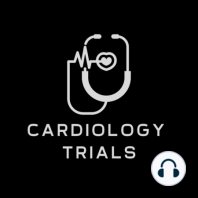37 min listen
Review of the PLATO Trial
ratings:
Length:
14 minutes
Released:
Apr 4, 2024
Format:
Podcast episode
Description
N Engl J Med 2009;361:1045-57.Background Similar to Prasugrel, Ticagrelor is a direct-acting oral antagonist of the adenosine diphosphate receptor P2Y12. Unlike clopidogrel that requires transformation of the prodrug to the active metabolite, Ticagrelor provides faster and more consistent P2Y12 inhibition.In the TRITON-TIMI 38 trial, Prasugrel compared to clopidogrel reduced myocardial infarction in patients with ACS but was associated with more major bleeding and subgroup interactions were evident for patients who were older, had a history of stroke or risk factors for bleeding and who were generally at higher risk for recurrent events.The Study of Platelet Inhibition and Patient Outcomes (PLATO) sought to test the hypothesis that Ticagrelor is superior to clopidogrel for the prevention of vascular events and death in patients presenting with ACS.Cardiology Trial’s Substack is a reader-supported publication. To receive new posts and support our work, consider becoming a free or paid subscriber.Patients Eligible patients were hospitalized for ACS, with or without ST-segment elevation (STE), whose onset of symptoms occurred within the previous 24 hours. For patients without STE, at least 2 of the following criteria were required: 1) ST-segment changes on ECG indicating ischemia, 2) a positive biomarker indicating myocardial necrosis, or 3) one or more risk factors including age ≥60 years, previous MI or CABG, CAD with stenosis of ≥50% in at least 2 vessels, history of ischemic stroke, TIA, carotid stenosis, cerebral revascularization, diabetes, peripheral arterial disease or CKD based on creatinine clearance <60 ml/min. STEMI was traditionally defined. Key exclusion criteria included any contraindication against the use of clopidogrel, fibrinolytic therapy within 24 hours, a need for oral anticoagulation, an increased risk of bradycardia, and concomitant therapy with a strong cytochrome P-450 3A inhibitor or inducer.Baseline characteristics The median age of patients was 62 years with 15% being ≥75 years and 72% were men; over 90% were white. The index event was UA or NSTEMI in approximately 60% and STEMI in 38%. Only 81% of patients underwent coronary angiography. PCI was performed in 64% of patients (was 99% in TRITON-TIMI 38) and CABG was performed in 10%. Interestingly, the majority of patients stented received only a bare metal stent (65%). 20% of patients had a prior MI, 25% had diabetes, 65% had hypertension and 36% were habitual smokers. Only 4% of patients had CKD defined as a creatinine clearance ≤60 ml/min or a history of ischemic stroke.Procedures All drugs were administered in a double-blind, double-dummy fashion. Ticagrelor was given as a loading dose of 180 mg followed by 90 mg twice daily for all patients. For patients who had not been on clopidogrel for at least 5 days prior to randomization, a 300 mg loading dose of clopidogrel was given followed by a dose of 75 mg daily. Others in the clopidogrel group continued to receive a maintenance dose of 75 mg daily.For patients undergoing PCI more than 24 hours after randomization, an additional dose of their study drug was given at the time of PCI, which was 300 mg of clopidogrel, at the investigator’s discretion, or 90 mg of ticagrelor. In patients undergoing CABG, it was recommended that the study drug be withheld for 5 days in the clopidogrel group and for 24 to 72 hours in the Ticagrelor group.Outpatient visits occurred at 1, 3, 6, 9, and 12 months, with a safety follow-up visit 1 month after the end of treatment, which was scheduled to continue for 12 months. Notably, patients left the study at their 6- or 9- month visit if the targeted number of primary endpoint events had occurred by that time.Endpoints The primary efficacy endpoint was the time to the first occurrence of a composite endpoint of death from vascular causes, myocardial infarction, or stroke. Investigators estimated that 1780 primary endpoint events would be required to achieve 90% power to detec
Released:
Apr 4, 2024
Format:
Podcast episode
Titles in the series (40)
Summary and discussion of CAST and ISIS-3 by Cardiology Trials
